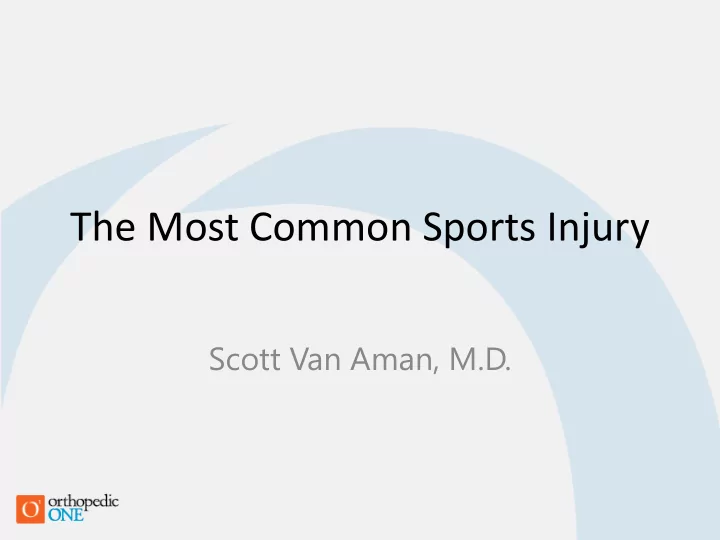

The Most Common Sports Injury Scott Van Aman, M.D.
Ankle Sprains • Inversion ankle sprains are the most common injury in sports • Up to 21% of all athletic injuries • 2.06 ankle sprains per 1000 people per year Foot Ankle 11:41-44 1990
Anatomy Peroneal Ankle Tendons Joint CFL ATFL
Mechanism of Injury • Inversion of Ankle • Tearing of lateral ligament complex
Mechanism of Injury
Diagnosis • Classic history • Lateral ecchymosis and tenderness over ATFL • Medial and/or more proximal pain can indicate more severe injury
Physical Exam Anterior Drawer Test
Diagnosis When are x-rays required? • Use the Ottawa Ankle Rules – Validated criteria for rotational ankle injuries JAMA 1994 271:827-832.
Diagnosis Ottawa Ankle Rules • Bony tenderness around the medial and/or lateral malleolus • Inability to weight bear • Validated for rotational ankle injuries only. – Does not rule out other possible associated injuries. JAMA 1994 271:827-832
Associated Injuries • Talar Dome OCD • Syndesmosis Injury • 5 th Metatarsal Fx • Anterior Process Calc Fx • Lateral Talar Process Fx • Peroneal tendon injury Talar Dome OCD
Sprain Classification Grade I • Minor strain w/o tear • No laxity Grade II • Partial tear • Increased laxity Grade III • Complete tear
Diagnosis Stress X-rays • No standard technique • Unclear what criteria define instability • Usually diagnosis is clinical JAAOS 1998 6:368-377
Initial Treatment R.I.C.E. Therapy • Rest • Ice • Compression • Elevation NSAIDs Bracing
Initial Treatment Surgery for Acute Ankle Instability? • Rarely indicated • Multiple studies have shown equivocal long term results when compared with functional rehabilitation • No long term difference in pain, swelling, stiffness or chronic instability JBJS 1991 73A:305-312
Rehabilitation Minor sprains • Self directed mobilization as tolerated • Functional bracing as needed
Rehabilitation Significant Injuries • Immobilization • Physical Therapy • Emphasis on peroneal tendon strengthening • Proprioception/balance
Rehabilitation When static ankle stabilizers (ATFL, CFL) are torn, stability is dependent on dynamic stabilizers (Peroneals)
Rehabilitation • Peroneal reflex arc takes 70 msec • Muscle force development takes 80 msec • Approximately 150 msec for pure reflex protection. Ortho Clin North Am 1994 25:147-60
Rehabilitation Activities that cause rapid unexpected deformation easily outstrip the protection of the peroneals
Chronic Instability Up to 20% of patients with acute injuries develop chronic ankle instability • Recurrent sprains • Pain and swelling • Difficulty negotiating uneven surfaces
Chronic Instability Conservative Care • Functional rehabilitation • Peroneal strengthening • Proprioception • Bracing
Chronic Instability Brostrom Ligament Reconstruction • ATFL and CFL imbricated • Repair reinforced with Inferior Extensor Retinaculum Acta Chir Scand 1966 132:551-65
Chronic Instability Brostrom Repair Results • Multiple studies have shown long term success rates of over 85% with up to 30 year follow-up Am J Sports Med 2006 34:975-8
Chronic Instability
“When is an Ankle Sprain Not an Ankle Sprain?”
When is an Ankle Sprain Not an Ankle Sprain? • There are several common injury patterns that can mimic or coincide with ankle sprains
Q: When is ankle sprain not an ankle sprain? A: In kids
Growth Plate Fractures • Weakest part of joint is the physeal plate not ligaments • Usually treated coservatively • Rare growth arrest
Q: When is ankle sprain not an ankle sprain? A: In kids
Tarsal Coalition • Recurrent “sprains” in adolescents • Failure of growing hindfoot bones to separate • Unilateral fixed flatfoot
Q: When is ankle sprain not an ankle sprain? A: When pain fails to improve as expected AND there is mechanical joint line pain
Osteochondral Lesion • Involve talar dome • Traumatic/idiopathic • Can cause catching or locking of joint and persistent aching or joint line pain
Q: When is ankle sprain not an ankle sprain? A: When pain fails to improve as expected AND there is lateral ankle and hindfoot pain
Peroneal Tendon Tear
Q: When is ankle sprain not an ankle sprain? A: When pain fails to improve as expected AND/OR there is lateral foot pain
5 th Metatarsal Base Fracture
Q: When Is Heel Pain Not Plantar Fasciitis? A: In kids
Sever’s Disease • Children get calcaneal apophysitis • Grow plate irritation • Always self limited • Stretching, ice, NSAIDs, heel cups
Thank You! Scott Van Aman M.D.
Recommend
More recommend